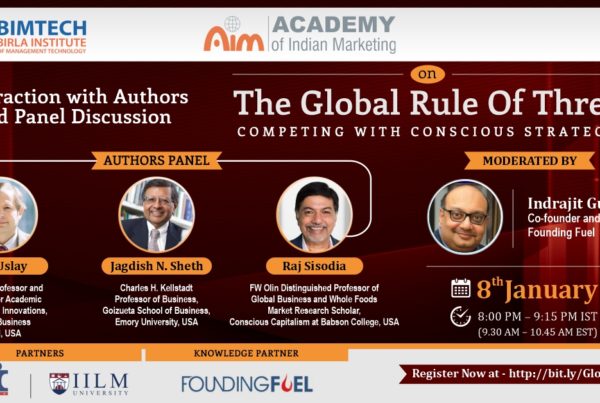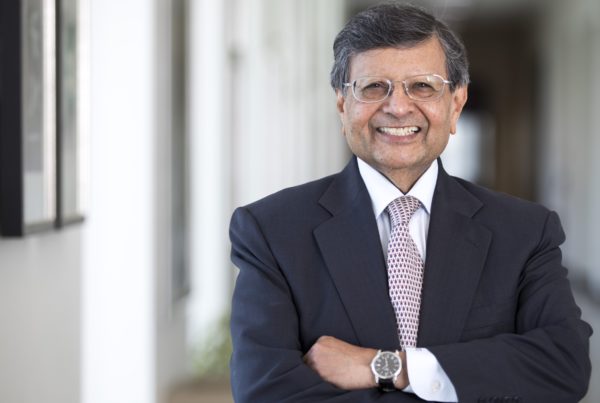Published: Feb 14, 2008 in Knowledge@Emory
A few years ago, Thomas Friedman ignited the business world with his book The World is Flat, in which he argues that the economic playing field between developing and developed countries is now level, meaning Americans and the entire developed world faced a much more competitive future than in the past. But now a professor of marketing and corporate strategist at Emory University’s Goizueta Business School has a theory that suggests maybe Friedman wasn’t quite right, and the world isn’t becoming “flat.” Instead, Professor Jagdish Sheth predicts that in the future, the world will actually be a bit bumpy.
In his latest book, Tectonic Shift (Sage, New Delhi, 2006), written in collaboration with Rajendra S. Sisodia, a professor of marketing at Bentley College in Waltham, MA, Sheth argues that over the next 20 years, the world economy will evolve not into a single “flat” market but three large trading blocs. Most trade will be conducted internally within these three large blocs – the Americas, Europe, and Asia – and all of them will thrive because of the many economic advantages that accrue to each party when developed and developing countries trade.
The idea came to Sheth in the late 1980s, he says, in the course of a consulting engagement with the government of Singapore. The small Asian city-state was trying to make plans for its future, and hired Sheth to help them make some long-range decisions.
Sheth says he realized in the course of his work for Singapore that the end of the Soviet Union had changed the ground rules of competition worldwide, not just for the eastern bloc. The century would belong to pragmatists, not ideologues. “There was a fundamental shift taking place. More and more, governments would be driven by markets and economies and less and less by ideology,” he says.
“There were three elements that came to my mind right away,” Sheth recalls. “The first element was that all advanced countries are aging enormously and therefore, they are not likely to have domestic growth. They will be desperate for growth, and the only place that growth will come would be, in fact, from large emerging economies like Russia, Brazil, India, China, Mexico, Egypt, and Turkey, etc. That meant that there had to be an economic integration between the emerging economies and advanced countries. More and more,” he says, “the advanced countries would need the emerging nations not for their resources like raw materials, but for their markets.”
Yet unlike some pundits, Sheth didn’t believe that all the world’s trade barriers would suddenly disappear. “The second discovery I made was that despite all of the globalization we talked about, the world had never globalized, except once, under the British Empire,” he says. For him, that made it clear that while trade liberalization would happen, it was politically much more likely to happen in smaller blocs. One book in particular, he says, helped him see what was happening: Triad Power, a 1985 book by the influential Japanese management consultant Kenichi Ohmae.
The third element was that trade would be the major driver of economic growth. In the last 25 years of the last century, most growth in the world’s economy grew out of trade between countries, Sheth says, not at home, and he thought this trend would continue.
The idea that the world would divide into three parts held a special attraction to Sheth, who is also the author of a competitive strategy book called The Rule of Three, which posits that most large companies in a given market eventually consolidate into a trio of three large competitors. “I believed that the Rule of Three is such a universal principle of organization that it has to happen in economic geography as well,” he says.
Sheth believes that Europe and the former Warsaw Pact countries will become increasingly integrated with the European Union. In the Americas, most of those countries will eventually band together in a kind of pan-hemispheric market. And in Asia, Japan, China, South Korea and most of the Asian countries will work together.
Yet there was more to the theory than simply drawing circles around continents or familiar groups of allies. For some players, he believes, cultural considerations will propel them to look for distant trading partners. India, Sheth predicts, will ally not only with China and Japan, but also with the U.S. and the UK. Historically, Sheth says, India has coexisted with China, but never allied with it. Instead, India will continue to draw itself increasingly closer to the U.S. At the same time, despite the cultural differences, he believes that Australia will increasingly look north toward the Asia Pacific countries for its future trade, in addition to its historical trade and investment with the United Kingdom and the U.S.
The Middle East will find itself drawn increasingly into the European orbit, drawn by geography, a long shared history, and ties with Russia left over from the Cold War. Israel too will pull towards Europe, drawn by a shared history and geography. Israel also will find itself trading more with its Arab neighbors, even the Palestinians. “Behind the scenes, Israelis and Palestinians have the same objectives – trade, economics, business – it’s the politics of the governments that get in the way,” observes Sheth.
Much of Africa and other ultra-poor “Fourth World” countries such as Bangladesh, Nepal and Bolivia will remain indefinitely outside the large trading blocs.
That’s the theory. Of course, the world has a way of behaving in ways that don’t always align with theories about how it should behave, no matter how logical the underpinnings of the idea. Sheth concedes that some short-run trends have surprised him since he first began making presentations on the theory in 1989. “I’ve been usually right so far, but a couple of changes are now taking place, and I’m now not so sure that some trends I mention in the book will continue,” he says.
The biggest developments: The growing popularity of leftism in South America, which helped scuttle the Free Trade Agreement of the Americas, has made him wonder if the Americas may grow into two or three trading blocs. So too has the virulence of radical Islam, which makes him wonder if the Arabs will need to develop their own trading bloc. “Unfortunately, I’m not so sure that right now any major group would like to have the Middle East bloc as part of their architecture.”
What does this all mean for the U.S.? “People always say this sounds so pessimistic for America,” notes Sheth. Actually, he says, he is still very optimistic about America’s future. Wealth is still very broadly held in the U.S., through homeownership, pensions, etc. Now through eBay, he says, there’s even a way to turn bric-a-brac around the house into money. “Out of junk we are creating wealth, which is very unusual.”
A second area of strength is the university system, he continues. Sheth believes that with 250 to 300 research oriented universities, higher education is likely to remain a competitive advantage for the U.S. for some time.
But perhaps his biggest reason for optimism, however, is that the U.S. adores entrepreneurs. “This country will always attract entrepreneurs,” he says. “We will create more entrepreneurs and attract more entrepreneurs.”
American society is unusual in the degree to which it respects wealth, Sheth says. “In other countries, if you become wealthy, you are less respected. Your respect comes from intellectual practices— you want to be a professor, you want to be a philosopher, you want to be a preacher to gain respect. But businessmen don’t get respect.”
Americans are different in that way. “We admire all the sports personalities, because they make enormous money, not because they’re talented…we admire show business people not because their lives would be worth emulating, their lives are often not worth emulating, but because they’re so wealthy,” observes Sheth. “We admire Bill Gates, who is a college dropout, but we ignore that side of him,” he says. Even the popularity of The Sopranos TV show, he says, is due in part to the fact that the mobster family depicted in the show are successful entrepreneurs – of a sort. “I think that is a very uniquely American phenomenon, the fact that Americans allow respect to come from entrepreneurship as much as through intellectual capability,” he says.





